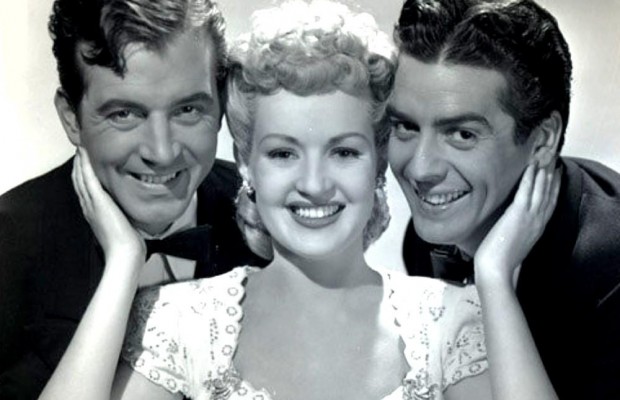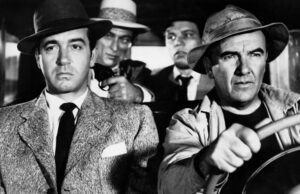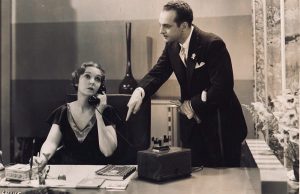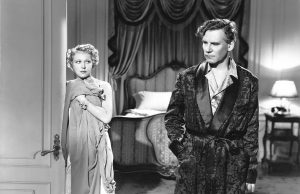Footlight Serenade (1948)

Toronto Film Society presented Footlight Serenade (1948) on Sunday, February 14, 2016 in a double bill with Dear Heart as part of the Season 68 Sunday Afternoon Film Buff Series, Programme 5.
Production Company: Twentieth Century Fox. Director: Gregory Ratoff. Producer: William LeBaron. Writing Credits: Kenneth Earl (story), Robert Ellis, Fidel LaBarba (story), Helen Logan and Lynn Starling. Music: Charles Henderson. Cinematography: Lee Garmes. Film Editor: Robert L. Simpson. Art Directors: Richard Day and Albert Hogsett. Set Decoration: Thomas Little. Costume Design: Earl Luick. Makeup: Guy Pearce. Dance Director: Hermes Pan.
Cast: John Payne (William J. ‘Bill’ Smith), Betty Grable (Pat Lambert), Victor Mature (Tommy Lundy), Jane Wyman (Flo La Verne), James Gleason (Bruce McKay), Phil Silvers (Slap), Cobina Wright (Estelle Evans), June Lang (June), Frank Orth (Mike, Stage Doorman), Mantan Moreland (Amos, Tommy’s Dresser), Irving Bacon (Stagehand), Charles Tannen (Charlie, Stage Manager), George Dobbs (Frank, Dance Director), Hermes Pan (Assistant Dance Director).
For Reagan, January 1942 meant Desperate Journey, followed by a stint in the service. For Jane, it meant another loan out, this time to Fox, where she had worked twice before: first as an unbilled lady of the chorus in King of Burlesque (1936), and then as a streetwise flier in Tail Spin (1939). Although Jane had little to do in Footlight Serenade (1942), a minor Betty Grable vehicle, she would not even have been in the picture if it had been filmed as planned.
In 1939, Kenneth Earl and Fidel LaBarba’s treatment, “A Straight Left (1939),” was under serious consideration at Fox, whose head of production, Darryl Zanuck, had been, among other things, an amateur boxer. Zanuck was drawn to the main character, a supposedly washed-up fighter who makes a spectacular comeback and then disappears, presumably drowned under mysterious circumstances. If the treatment had continued to final screenplay stage, someone along the way would have realized that it had the makings of an effective melodrama, not a musical. LaBarba was the one who should have known; he was a professional boxer, as well as a Stanford University alumnus. His journey from the Bronx to Stanford to Hollywood was American Dream material. But in golden age Hollywood, one pair of writers was often shadowed by another working on the same project. The expectation was that, between them, a filmable script would emerge. The final credits attribute the screenplay, “based on a story by Fidel LaBara and Kenneth Earl,” to Robert Ellis, Helen Logan, and Lynn Starling. If anyone contributed to the authenticity of the fight sequences, it would have been LaBarba, whose life merited a movie of its own. All Footlight Serenade owed to the treatment was the boxing background.
Footlight Serenade was a tour de force for Victor Mature, playing a self-enraptured boxer recruited for a musical revue with a boxing match finale. It is hard to know if Jane appeared in the dance sequences. Since she wore the costumes, one would assume she did so—but without the identifying close up. Jane, however, was too good a dancer to need a double. As was common during the palmy days of the movie musical, the dance sequences were filmed in long shot, so it was obvious that a double was not being used. If a double were needed, a medium shot would be followed by an extreme long shot with similarly dressed performers, whose features were not delineated. Grable did not need a double, either; she was a talented dancer and a high kicker—not to mention having the best legs in Hollywood. Jane had some wise cracks and one good scene in which Mature needed money to foot a bill. Jane emptied her purse on a table, but realizing there was no money among the contents, discreetly pulled a bill from her bra.
Jane had one line that, in retrospect, appears quasi-prophetic. When Grable announces that she has become the star’s understudy, the cynical Flo (Jane) replies, “You have as much of a chance being [the star’s] understudy as I have of being the first lady.” Jane might have become the first lady if she had remained married to Ronald Reagan, although it is doubtful that the White House would have been her kind of home.
The President’s Ladies: Jane Wyman and Nancy Davis by Bernard F. Dick (2014)
Conceited boxer Tommy Lundy (Victor Mature) sets his sights on Broadway, taking the central role in a play where he falls for dancer Pat Lambert, who is secretly dating another one of the actors, Bill Smith. When Bill and Pat get married, Pat maintains the secrecy of their relationship for fear it will adversely impact on her career, much to the annoyance of Bill, who grows weary of Tommy’s advances towards his wife. Cast as Tommy’s sparring partner in the show, Bill finally gets to vent his anger when in the ring he deals Tommy a knock-down blow. When Tommy discovers that he’s been chasing a married woman, he does the decent thing and bows out of the picture.
Once Betty Grable proved herself a natural at musical comedy, Zanuck put her to work in Footlight Serenade which, unlike the norm for Fox musicals, was shot in black and white. With the war on, color stock was in short supply and the studio had already used up its allocation on other features. However, with the film’s runaway success, it proved that all a good musical needed was bouncy song and dance numbers and a fabulous cast to woo audiences, and that Technicolor was simply icing on the cake. Zanuck was pleased with the end result, but inserted a clause into Grable’s contract ensuring that all her future films were to be shot in Technicolor.
This time, Grable had two of Fox’s leading men chasing after her, Mature and John Payne. A well-established star at Fox, Payne took top billing over Grable and Mature. But with Mature’s over-the-top role, as an extrovert boxer, and his natural ability to ham it up “good style” he simply stole the show. Grable, Payne and Mature had been scheduled to play in a lighthearted drama titled White Collar Girl, but persistent script problems mothballed the project. With cast, crew and resources already committed, another production was quickly needed, and Footlight Serenade nicely fitted the bill.
For direction, Zanuck assigned Russian-born Gregory Ratoff, who had served in the czar’s army and fought in World War I. Escaping the Bolshevik revolution, he eventually settled in America. Starting his Hollywood career as actor in the 1930s, he later moved into direction, his most notable film being Intermezzo (1939), which saw Ingrid Bergman in her first Hollywood role.
As Phil Silvers recalled, Ratoff’s thick Transylvanian-gypsy accent, which led to his hilarious distortion of the English language, was a constant source of amusement on set. Silvers described how in one scene, Ratoff was instructing Grable how to play up to Mature’s character to secure a part in the show: “You arr chrruss girrl and he ees beeg star from price fighting, but now in show, you want to make heem think he’s terrific. You want to play up to heem. You want to suck heem.” What he meant was to flatter him, by sucking up to him, but everyone interpreted it another way, which led to much laughter and the suspension of work for five minutes, with Ratoff innocently inquring, “What did I sayed?” Grable never let him forget it, for in subsequent scenes, before the camera rolled, she would lean toward Mature’s belt and ask, “I do it now?”
By all accounts, Mature’s character was based on the colorful former heavyweight champion Max Baer, who had a reputation as a bit of a partygoer, often at the expense of his training, which cost him dearly when he was knocked out in 1935 by unemployed longshoreman Well Braddock, “The Cinderella Man” (Possibly the inspiration behind Sly Stallone’s Rocky). Mature was trained by former contender Jack Roper before stepping into the ring with Payne, who already had some boxing experience. For the three fight scenes, Lloyds of London had to write $50,000 policies on both Mature and Payne. But injury during production was to occur elsewhere, when Grable tore her abdominal muscles when she hit the deck while carrying out a dance movement with Mature. Her other dance scenes were postponed to allow her time to heal.
Mature certainly looks the part of a boxer, and it would have been great to have seen him in a serious boxing film of the noir genre. The closest we get to this type of sporting characterization is his over-the-hill pro football player in Easy Living (1949). Despite looking the part, Mature was a big softie at heart, as co-star Phil Silvers recalled: “Mature, a virile womanizer and very intelligent, was surprisingly gentle for a muscleman. He abhorred violence, couldn’t stand anyone hitting him with a glove or even touching him.”
This larger-than-life character was certainly in the Mature mold, giving the actor a great opportunity to convey an over-emphasized impression of himself, a role he truly enjoyed judging by his energetic performance, particularly in the hilarious scene where he dispenses unexpected electric shocks during every handshake with his hand-held buzzer. Ratoff kept the pace brisk and Mature proved that he was more than up to it with his superb comic timing and a brash way with a line. When Grable accuses him of chasing her, he idly quips, “Lady, I’ve been trying to sprinkle salt on your tail for a long time, but I can’t get near you.” But it takes more than sharp patter to win Grable’s character over. When Mature asks her, “’Will you come into my dressing room?’ said the spider to the fly,” she responds, “Oh, thank you, Mr. Spider, but I’m very, very shy.”
The film’s other hunk, John Payne, had a lot going for him, ruggedly handsome and equally adept in light musicals and action films, but he never quite joined the ranks of the major stars of the day. Like Dick Powell, he was another singer turned tough guy, and will always be remembered for his part in Miracle on 34th Street (1947), but for my money, his best roles were in film noir: The Crooked Way (1949), Kansas City Confidential (1952), 99 River Street (1953), Hell’s Island (1955) and Slightly Scarlet (1956). Interestingly, he was the first person in Hollywood to show an interest in making the James Bond novels into a film series, but dropped the project when he couldn’t secure the rights to the entire 007 series. In 1961, he suffered life-threatening injuries when he was struck by a car in New York, and had to have six hours of surgery on his face. In 1943, during a spot of leave while serving in the U.S. Coast Guard service, Mature dated Payne’s ex-wife, actress Anne Shirley, and there was even talk of marriage, but nothing came of it.
Such was the talent on offer, we also had Jane Wyman playing Grable’s straight-laced friend and fellow chorus girl. Wyman was not only an excellent actress, receiving an Academy Award for her performance in Johnny Belinda (1948), but she was also the first wife of Ronald Reagan, in a marriage that lasted from 1940 to 1948. In 1984, she was quoted as saying “Women are like tea bags. You never know how strong they are until you put them in hot water.” In Footlight Serenade, Wyman, on her first encounter with Mature’s character Tommy Lundy, dismissively describes him as a “fresh guy,” and he later sarcastically refers to her as, “hatchet face.” Further verbal sparring between these two would have worked a treat, in my opinion, but it was not to be.
With James Gleason and Phil Silvers on hand once more, providing solid light hearted support, the show moved along at a lively clip. And in the choreography department, Hermes Pan again proved he was a force to be reckoned with, providing Grable with some truly memorable dance routines. Particular mention should be made of the novel boxing sequence where Grable boxes with herself and the brilliant dance duet she does with Pan. The songs, which came courtesy of Leo Robin and Ralph Rainger, included “Are You Kidding?” “I’m Still Crazy for You,” “I Heard the Birdies Sing,” “Living High,” “I’ll Be Marching to a Love Song,” and “Land on Your Feet.”
Mature took third billing after Payne and Grable, so it was a dead certainty that he’d end up losing the girl, just as his third billing in No, No, Nanette lost him Anna Neagle to Richard Carlson. As well as giving Grable ample opportunity to show off her legs (or gams, as she referred to them), the film provided Mature with a rare opportunity to dance when Grable tries to teach him how to waltz, which included him hoisting her onto his shoulder and catching her when she descends (a routine that resulted in her abdominal injury). Mature was certainly no threat to Gene Kelly, but what he lacked in hoofing skills, he more than made up for with his breezy manner and his amazing ability to flip cigarettes into his mouth, catching them neatly between the lips each time. This is Mature at his most brash and conceited, adding that final touch to a great musical; they certainly don’t make ‘em like this any more. A Newsweek reviewer wrote that the high point of the film is “probably Mature’s confident interpretation of the brash, immature lady killer. While there are those who will discount this performance as a triumph of type casting, Mature manages the role with the saving grace of humor and self-kidding.”
Variety: “Although Mature successfully pictures the egoistic and swaggering fight champ for reverse angles, he’s painted with lily-white duco for the finish, which will be alright with the women customers.”
The Radio Times Guide to Films: “This film contains some very pleasing performances, including a lightly self-mocking one from hulk Victor Mature as a Broadway-bound boxer.”
Mature would once again take to self-mocking, to glorious effect, 24 years later in the film that brought him out of retirement, After the Fox (1966).
The Films of Victor Mature by James McKay (2013)
Notes compiled by Caren Feldman
www.carensclassiccinema.wordpress.com













Leave a Reply